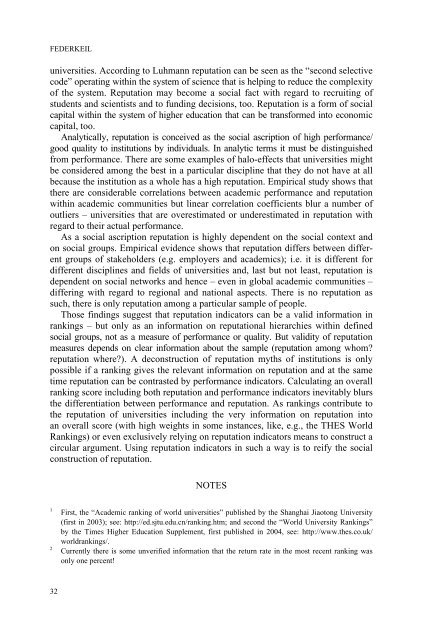University Rankings, Diversity, and the New ... - Sense Publishers
University Rankings, Diversity, and the New ... - Sense Publishers
University Rankings, Diversity, and the New ... - Sense Publishers
Create successful ePaper yourself
Turn your PDF publications into a flip-book with our unique Google optimized e-Paper software.
FEDERKEIL<br />
universities. According to Luhmann reputation can be seen as <strong>the</strong> “second selective<br />
code” operating within <strong>the</strong> system of science that is helping to reduce <strong>the</strong> complexity<br />
of <strong>the</strong> system. Reputation may become a social fact with regard to recruiting of<br />
students <strong>and</strong> scientists <strong>and</strong> to funding decisions, too. Reputation is a form of social<br />
capital within <strong>the</strong> system of higher education that can be transformed into economic<br />
capital, too.<br />
Analytically, reputation is conceived as <strong>the</strong> social ascription of high performance/<br />
good quality to institutions by individuals. In analytic terms it must be distinguished<br />
from performance. There are some examples of halo-effects that universities might<br />
be considered among <strong>the</strong> best in a particular discipline that <strong>the</strong>y do not have at all<br />
because <strong>the</strong> institution as a whole has a high reputation. Empirical study shows that<br />
<strong>the</strong>re are considerable correlations between academic performance <strong>and</strong> reputation<br />
within academic communities but linear correlation coefficients blur a number of<br />
outliers – universities that are overestimated or underestimated in reputation with<br />
regard to <strong>the</strong>ir actual performance.<br />
As a social ascription reputation is highly dependent on <strong>the</strong> social context <strong>and</strong><br />
on social groups. Empirical evidence shows that reputation differs between different<br />
groups of stakeholders (e.g. employers <strong>and</strong> academics); i.e. it is different for<br />
different disciplines <strong>and</strong> fields of universities <strong>and</strong>, last but not least, reputation is<br />
dependent on social networks <strong>and</strong> hence – even in global academic communities –<br />
differing with regard to regional <strong>and</strong> national aspects. There is no reputation as<br />
such, <strong>the</strong>re is only reputation among a particular sample of people.<br />
Those findings suggest that reputation indicators can be a valid information in<br />
rankings – but only as an information on reputational hierarchies within defined<br />
social groups, not as a measure of performance or quality. But validity of reputation<br />
measures depends on clear information about <strong>the</strong> sample (reputation among whom?<br />
reputation where?). A deconstruction of reputation myths of institutions is only<br />
possible if a ranking gives <strong>the</strong> relevant information on reputation <strong>and</strong> at <strong>the</strong> same<br />
time reputation can be contrasted by performance indicators. Calculating an overall<br />
ranking score including both reputation <strong>and</strong> performance indicators inevitably blurs<br />
<strong>the</strong> differentiation between performance <strong>and</strong> reputation. As rankings contribute to<br />
<strong>the</strong> reputation of universities including <strong>the</strong> very information on reputation into<br />
an overall score (with high weights in some instances, like, e.g., <strong>the</strong> THES World<br />
<strong>Rankings</strong>) or even exclusively relying on reputation indicators means to construct a<br />
circular argument. Using reputation indicators in such a way is to reify <strong>the</strong> social<br />
construction of reputation.<br />
NOTES<br />
1<br />
2<br />
First, <strong>the</strong> “Academic ranking of world universities” published by <strong>the</strong> Shanghai Jiaotong <strong>University</strong><br />
(first in 2003); see: http://ed.sjtu.edu.cn/ranking.htm; <strong>and</strong> second <strong>the</strong> “World <strong>University</strong> <strong>Rankings</strong>”<br />
by <strong>the</strong> Times Higher Education Supplement, first published in 2004, see: http://www.<strong>the</strong>s.co.uk/<br />
worldrankings/.<br />
Currently <strong>the</strong>re is some unverified information that <strong>the</strong> return rate in <strong>the</strong> most recent ranking was<br />
only one percent!<br />
32














